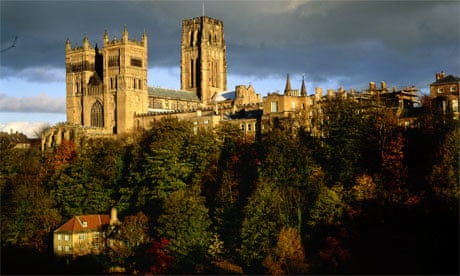After almost 30 years, the riverbed below Durham Cathedral has given up a bewildering secret: a hoard of ecclesiastical gold and silver, including medals, goblets, and crucifixes once owned by the Queen, the pope and other state and church leaders.
A total of 32 objects given as gifts to the late Michael Ramsey – a former archbishop of Canterbury who was bishop of Durham for four years in the 1950s and spent some of his retirement in the city – have been recovered from deep in the bed of the river Wear by two amateur divers, brothers Gary and Trevor Bankhead.
Their finds include gold, silver and bronze medals struck to commemorate the second Vatican council, which must have been presented when Ramsey – archbishop of Canterbury from 1961 to 1974 – met Pope Paul VI at the Vatican in 1966.
The Bankhead brothers, who made some 200 dives over two years under licence from the cathedral, also discovered a solid gold Japanese medal probably presented when Ramsey met Nikkyo Niwano, president of the Japanese Buddhist movement, in 1973.
The first finds were made in April 2007. Gary, watch manager on Green Watch at Durham fire brigade, said he was sitting with his wife Angela in a coffee shop on the corner of the Framwellgate bridge, when she suggested he should dive some day in the river 10 minutes from his home.
He brought along Trevor, a former soldier, and on their first dive they found an ornate silver trowel buried in the shingle. To their amazement, its inscription said it was presented to the archbishop on 9 December 1961 by the Bengal Coal Company, when he laid the foundation stone of a church in India.
On their next dive they found another piece clearly linked to Ramsey and approached the initially suspicious cathedral authorities, who eventually granted them a licence to search for more.
The brothers – who wore out three drysuits, cut to shreds by rubbish and sharp stones in the river – also found a silver medal commemorating the Queen's coronation in 1953, in which Ramsey took part as bishop of Durham, and others presented by the patriarchs of the Russian and Greek Orthodox churches.
The cathedral authorities, which own both banks of the picturesque stretch of the river where it flows beneath its walls, are baffled by the strange collection of gleaming gold and corroded silver. The last find was on Sunday this week and the cathedral authorities are certain all Ramsey objects – which are in a cathedral safe – have now been recovered from the river.
One theory at the cathedral is that there may have been a burglary at the retirement home Ramsey moved to in 1974 when he left Lambeth Palace. Ramsey and wife Joan lived in a tall, handsome Georgian house on the edge of the Durham cathedral precinct, just 150 yards uphill from Prebends bridge where most of the finds were made.
However others believe that Ramsey – a brilliant but eccentric and unworldly man – quietly dropped them into the river himself, at a loss to know what else to do with them. As his friend the Very Rev Victor Stock, dean of Guildford, who stayed with him every year in Durham, said: "That is so Michael Ramsey."
Stock says Ramsey was embarrassed when he sold some pieces he was given after retirement, and gave every penny to Christian Aid. Some items reappeared on the market, upsetting the donors.
"When he and Joan were packing up that house, both quite elderly and not very well, he would have wondered what on earth to do with the rest of the stuff: he didn't want it, they had no children, he couldn't sell it, he wouldn't have wanted to cause further embarrassment by giving it away," said Stock.
"He used to go for a walk by the river every day, whatever the weather. I think it's entirely plausible to imagine him making up a little packet, and quietly dropping it into the water. He would have thought that would be the end of it, nobody would ever see them again."
Gary Bankhead also believes the archbishop himself put the pieces in the river, but as a votive offering to the city he loved. "They weren't just chucked by a burglar – they had clearly gone into the water at different times and in different places."
Recovering the objects was quite a task. Metal detectors proved useless because there was so much junk in the river, so the brothers located many pieces by throwing handfuls of shiny steel washers off Prebends bridge, and watching where they fell.
Usually the brothers were working in minimal visibility, sometimes in water so cold their air lines iced up, shifting tonnes of shingle by hand to get down to the bedrock where pieces – including hundreds of unrelated medieval and later objects – were lodged in crevices, all the while worried about being run down by passing tourist boats. Their only reward so far has been a £100 contribution from the cathedral towards their air tanks, and finding enough modern coins to pay their parking charges.
Precise legal ownership of the pieces, and their value, has still to be established. By coincidence the cathedral is already planning to unveil a stained-glass window commemorating Ramsey next year, and is collecting oral histories for an exhibition on his life. The story of the treasure in the river, and some of the objects, may now become part of it.
